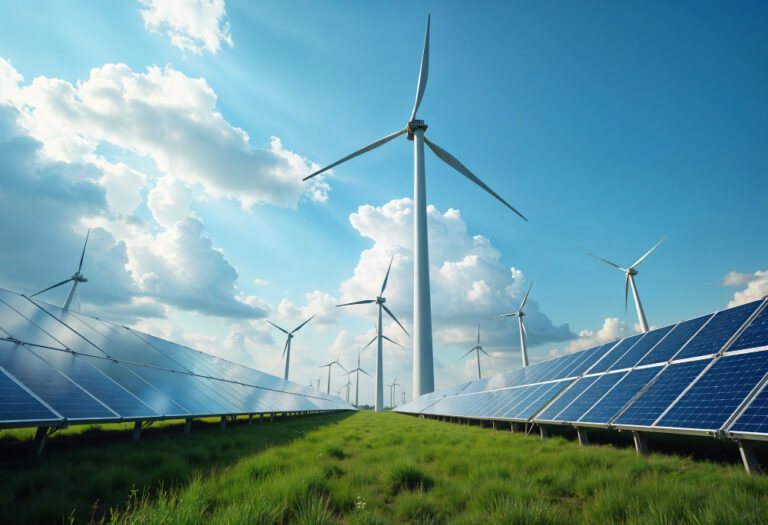The Hidden Risks of Renewable Energy Investing: What Every Investor Needs to Know (and How to Mitigate Them)

The global pursuit of a sustainable future has propelled renewable energy into the investment spotlight. Driven by the urgent imperative of climate action, rapid technological advancements, and an unprecedented surge in public and private capital—with global clean energy investment projected to reach $2.2 trillion in 2025 according to the International Energy Agency (IEA)—the sector gleams with promise. The narrative of “green growth” and “ethical investing” is compelling, attracting a diverse range of investors eager to align their portfolios with purpose and profit.
However, beneath the radiant facade of endless sunshine and constant wind, the renewable energy sector, like any burgeoning industry, harbors unique complexities and risks of renewable energy investing that can significantly impact returns. For many investors, particularly those new to this dynamic space, these “hidden” risks are often overlooked. This article aims to candidly reveal these specific challenges, moving beyond generic warnings to provide actionable strategies to mitigate clean energy investment risks. We’ll explore the technical, market, regulatory, financial, and environmental/social pitfalls, equipping you with the knowledge to approach this revolution with confidence. Our core message: Smart investing in renewables means understanding the specific energy-sector nuances and employing a layered risk management approach.
- 1. The Intermittency Challenge: Technical & Operational Risks in Renewable Energy Projects
- 2. Navigating the Currents: Market & Price Volatility Risks
- 3. The Policy Climate: Regulatory & Political Risks (Policy Risk Clean Energy)
- 4. Funding the Future: Financial Risks & Project Financing Challenges
- 5. Beyond the Balance Sheet: Environmental & Social (ESG) Risks
- Conclusion: Investing Smart in the Green Revolution
- Frequently Asked Questions (FAQs) About Renewable Energy Investment Risks
- Q1: Are renewable energy stocks generally more volatile than traditional energy stocks?
- Q2: How does government policy (like the IRA) specifically create risk for renewable energy investors?
- Q3: What are Power Purchase Agreements (PPAs), and how do they reduce risk?
- Q4: Should I invest in individual renewable energy companies or an ETF to mitigate risk?
- Q5: What role does grid capacity play in renewable energy investment risk in 2025?
1. The Intermittency Challenge: Technical & Operational Risks in Renewable Energy Projects
Renewable energy harnesses natural forces, which inherently introduces a level of unpredictability into power generation. This reliance on environmental conditions presents distinct technical risks renewable energy investors must understand.
- Resource Variability:
- Solar & Wind: The most prominent renewable sources, solar and wind, are inherently weather-dependent. Periods of low sunlight or calm winds directly translate to lower-than-expected energy generation, impacting a project’s revenue.
- Hydropower: While a reliable baseline, hydropower is susceptible to droughts, as seen in various regions globally, leading to significant output reductions.
- Impact: Lower generation directly impacts project profitability and the ability to meet projected returns.
- Equipment Failure & Degradation:
- Even with advancements, solar panels, wind turbines, and battery storage systems can experience unexpected failures or gradual performance degradation over their operational lifespan. This necessitates unforeseen maintenance or costly replacements.
- Newer, cutting-edge technologies might lack extensive long-term operational data, making it difficult to fully assess their reliability and potential for major financial or operational setbacks. For instance, while lithium-ion batteries are common, ongoing research into alternative chemistries highlights evolving risks and safety concerns (e.g., thermal runaway).
- Data: Pinsent Masons highlights the risks associated with new and untested technologies lacking long-term feasibility assessment.
- Mitigation Strategies:
- Technological and Geographic Diversification: Spread investments across a mix of renewable technologies (solar, wind, hydro, geothermal) and diverse geographic regions. This hedges against localized weather patterns or single-technology performance issues.
- Robust Due Diligence: Prioritize thorough technical assessments of project design, equipment quality, and the track record of suppliers and manufacturers. Invest in projects utilizing proven, high-quality components.
- Performance Guarantees & Warranties: Ensure contracts include strong performance guarantees from equipment manufacturers and EPC (Engineering, Procurement, and Construction) contractors, covering expected output and equipment lifespan.
- Advanced Forecasting & Monitoring: Companies employing AI and machine learning for accurate resource prediction and real-time performance monitoring can optimize output and proactively address issues, as noted by the Sustainability Directory.
2. Navigating the Currents: Market & Price Volatility Risks
Beyond the physical operation of a renewable asset, its financial success is highly sensitive to market dynamics, introducing significant market risk to renewable projects.
- Electricity Price Fluctuations:
- Wholesale electricity prices are volatile, influenced by supply and demand, the cost of traditional energy sources (like natural gas), and grid congestion. Oversupply of renewables during peak generation times (e.g., midday solar, windy nights) can drive prices down, impacting revenues for projects selling into the spot market.
- Data: EY and Green Rhino Energy both emphasize how unpredictable electricity prices can create significant renewable energy stock volatility. Strategic Energy in May 2025 noted concerns about dysfunctional energy pricing and declining returns for utilities amidst market shifts.
- Increased Competition:
- As the renewable energy sector matures and attracts more participants, competition for new projects, land acquisition, and long-term power purchase agreements (PPAs) intensifies. This can compress profit margins and make securing new deals more challenging.
- Demand Shifts:
- While overall energy demand is growing, unforeseen economic downturns, energy efficiency advancements, or shifts in industrial consumption patterns could impact the long-term demand for electricity, affecting project viability.
- Mitigation Strategies:
- Long-Term Power Purchase Agreements (PPAs): This is perhaps the most crucial de-risking tool. Secure stable revenue streams by locking in electricity prices with creditworthy off-takers (utilities, corporations) for extended periods (typically 10-20+ years). This significantly reduces exposure to the market price volatility impact on solar and wind projects.
- Diversified Revenue Models: Invest in companies that operate a mix of projects with PPAs and those selling into the merchant market or offer diversified services like energy storage, grid services, or distributed generation.
- Hedging Strategies: For projects with exposure to merchant (spot) electricity prices, financial derivatives (futures, forwards) can be used to manage price exposure, though this adds complexity.
3. The Policy Climate: Regulatory & Political Risks (Policy Risk Clean Energy)
The renewable energy sector’s growth has been heavily shaped by government policies and incentives. This reliance creates a distinct policy risk clean energy investors must monitor.
- Policy Instability & Reversals:
- Renewable projects often depend on government support mechanisms like tax credits (e.g., the U.S. Inflation Reduction Act—IRA), subsidies, feed-in tariffs, or renewable energy mandates. Changes in political leadership (like the US election’s impact on IRA in 2025 scenarios) or shifting policy priorities can lead to adjustments or even reversals of these crucial incentives. This directly affects project economics and investor confidence.
- Data: Utility Dive (April 2025) reported that policy uncertainty, particularly around the IRA’s fate, led to a sharp decline in Q1 2025 financing deals for solar, energy storage, and smart grid companies, with Mercom Capital Group CEO Raj Prabhu suggesting it could trigger a “sector-specific recession” due to stalled activity. US SIF and Aberdeen Investments also highlight the increased divergence in sustainable investing commitments globally, impacting regulatory stability.
- Permitting & Interconnection Delays:
- Lengthy, complex, and often unpredictable approval processes for new projects and their connection to existing grids are significant bottlenecks. The sheer volume of projects in interconnection queues can cause multi-year delays, increasing costs and pushing back revenue generation.
- Data: The IEA (March 2025) and Darwin Recruitment highlight grid integration challenges for renewable energy as a major bottleneck. The Low Carbon Agriculture Show (Feb 2025) notes that new grid connection reforms, like “first ready, first connected,” are being implemented to clear backlogs, but this is an ongoing challenge.
- Trade Tariffs & Geopolitical Tensions:
- The globalized renewable energy supply chain heavily relies on components from specific regions (e.g., China’s dominance in solar PV manufacturing). Geopolitical tensions, trade wars, tariffs, and export controls can lead to increased component costs, supply shortages, and project delays.
- Data: TÜV SÜD and U.S. Bank emphasize this vulnerability. Dynamic Design (April 2025) highlights China’s 95-97% control over rare earth elements (critical for wind turbines) and material shortages for battery metals (lithium, cobalt, copper) as major threats to global green energy targets in 2025.
- Mitigation Strategies:
- Geographic Diversification: Spread investments across different countries and regions with diverse, ideally stable and bipartisan, energy policies.
- Focus on Market-Driven Viability: Prioritize projects that are economically viable even with reduced or absent subsidies, relying more on falling technology costs and strong demand.
- Active Engagement: Invest in companies that actively engage with policymakers and industry bodies to advocate for stable, long-term policy frameworks.
- Robust Contracting: Ensure project contracts account for “change in law” and “force majeure” clauses, particularly in international projects, to manage regulatory shifts.
4. Funding the Future: Financial Risks & Project Financing Challenges
The capital-intensive nature of renewable energy projects exposes investors to various financial risks throughout their lifecycle.
- High Upfront Capital Requirements:
- Building utility-scale solar farms, wind parks, or geothermal plants requires substantial initial investment, making projects sensitive to financing costs and access to capital.
- Data: EY and Farrelly Mitchell consistently emphasize the significant upfront capital needed for renewable energy infrastructure.
- Interest Rate & Inflation Fluctuations:
- Rising interest rates directly increase the cost of debt financing, which is crucial for many renewable energy projects. Higher interest rates can reduce project internal rates of return (IRR), making projects less attractive. Inflation can simultaneously drive up the cost of materials, labor, and transportation.
- Data: Strategic Energy (May 2025) explicitly states that capital costs for renewable projects have risen significantly due to regulatory risk, inflation, and high interest rates.
- Construction Delays & Cost Overruns:
- Beyond permitting, actual construction can face delays due to unforeseen site conditions, labor shortages, adverse weather, or supply chain resilience issues in renewable energy (e.g., shortages of transformers and cables). These delays lead to cost overruns and push back the start of revenue generation.
- Data: FM Global’s 2025 survey identified rising equipment costs, supply chain disruptions, and regulatory/permitting delays as top construction risks. Lewis Woolcott and ResearchGate further detail the adverse impacts of project delays.
- Counterparty Risk:
- The risk that a key entity involved in the project—such as the off-taker of a PPA, an equipment manufacturer providing a warranty, or a construction contractor—defaults on their obligations. This can jeopardize revenue, performance, or project completion.
- Mitigation Strategies:
- Fixed-Price EPC Contracts: Lock in construction costs and timelines with reputable engineering, procurement, and construction (EPC) contractors through fixed-price agreements with strong delay damages clauses.
- Robust Financial Modeling & Contingency Planning: Build comprehensive financial models that include conservative assumptions and adequate contingency budgets for unforeseen costs and delays.
- Diversified Funding Sources: Explore a mix of debt, equity, green bonds, and government grants to reduce reliance on any single funding avenue.
- Comprehensive Insurance: Secure a robust insurance package covering construction risks, operational risks, and potentially political risks, as highlighted by ResearchGate and FM Global.
- Experienced Developers: Prioritize investing in companies with a proven track record of successful project financing and execution, as their experience significantly de-risks the renewable energy project financing risks.
5. Beyond the Balance Sheet: Environmental & Social (ESG) Risks
While inherently “green,” renewable energy projects can still carry significant environmental and social risks if not managed properly. These fall under broader ESG (Environmental, Social, and Governance) considerations.
- Land Use & Biodiversity Impact:
- Large-scale solar farms and wind projects require substantial land, which can sometimes lead to conflicts over agricultural land, pristine natural habitats, or scenic views. This can result in local opposition and project delays.
- Data: The Sustainability Directory notes land use concerns. PVknowhow (March 2025) specifically mentions land acquisition challenges and local opposition as key issues for solar and wind.
- Community Opposition (NIMBYism):
- “Not In My Backyard” (NIMBY) sentiment can arise from local communities concerned about visual impact, noise pollution (from wind turbines), or perceived devaluation of property. This opposition can lead to protracted legal battles or even project abandonment.
- Ethical Supply Chain & Critical Minerals:
- The growing demand for critical minerals (lithium, cobalt, rare earths, and copper) used in batteries, solar panels, and wind turbines raises concerns about their sourcing. Mining these materials can involve significant environmental damage, unethical labor practices, and conflict financing in source countries.
- Data: Achilles highlights ethical sourcing challenges. Dynamic Design (April 2025) points out the risks associated with raw materials for wind turbines and EVs, noting China’s 95-97% dominance in rare earth elements and potential supply gaps for lithium, nickel, graphite, cobalt, neodymium, and copper by 2040.
- Mitigation Strategies:
- Thorough Environmental & Social Impact Assessments (ESIAs): Conduct comprehensive ESIAs early in the project lifecycle to identify and address potential negative impacts on ecosystems and communities.
- Proactive Community Engagement: Engage with local communities early, transparently, and respectfully. Address their concerns, offer community benefits (e.g., job creation, local energy ownership), and build strong local support for the project.
- Sustainable & Ethical Sourcing: Prioritize suppliers with strong ethical and environmental track records. Push for greater supply chain transparency and traceability, seeking third-party verified certifications.
- Site Selection: Carefully select project sites that minimize environmental disruption and community conflict.
- ESG Certifications: Support companies that pursue and maintain robust ESG certifications (like B Corp, ISO 14001), demonstrating a commitment to broader sustainability beyond just energy generation.
Conclusion: Investing Smart in the Green Revolution
The global shift towards renewable energy represents an undeniable force, offering unparalleled growth opportunities and a chance for investors to contribute to a sustainable future. However, it is crucial to recognize that this transition is not without its specific risks of renewable energy investing. From the inherent intermittency of natural resources to complex policy shifts, grid integration hurdles, financial pressures, and ethical supply chain considerations, the clean energy sector presents unique challenges.
Our core message remains: smart investing in renewables means understanding the specific energy-sector nuances and employing a layered risk management approach. By candidly acknowledging these complexities and implementing robust mitigation strategies—through strategic diversification, rigorous due diligence, robust contractual agreements, comprehensive insurance, and a focus on ethical practices—investors can significantly enhance the safety and potential returns of their green portfolios.
Despite these risks, the long-term trajectory towards a decarbonized world is resolute. Ongoing technological advancements, increased investment in grid modernization and energy storage, and continued (though potentially fluctuating) policy support will fuel the sector’s expansion. The well-informed, proactive investor, equipped with a comprehensive understanding of both opportunities and clean energy investment risks, is best positioned to navigate this transformative period and thrive in the green revolution.
Are you ready to invest in renewable energy with greater confidence? What are your biggest concerns, or what successful risk mitigation strategies have you employed in your green investments? Share your insights and questions in the comments below—let’s build a more resilient and sustainable investment future together!
Frequently Asked Questions (FAQs) About Renewable Energy Investment Risks
Q1: Are renewable energy stocks generally more volatile than traditional energy stocks?
A: Yes, renewable energy stocks can exhibit higher volatility compared to traditional fossil fuel stocks. This is often due to their sensitivity to government policies and incentives, commodity price fluctuations (though less direct than fossil fuels), and the early-stage nature of some technologies. While traditional energy stocks are linked to oil and gas price volatility, renewable stocks have their own unique drivers of instability, including project development risks and grid integration challenges.
Q2: How does government policy (like the IRA) specifically create risk for renewable energy investors?
A: Government policies like the U.S. Inflation Reduction Act (IRA) provide significant incentives (e.g., tax credits) that are crucial for the economic viability of many renewable energy projects. The risk arises from policy uncertainty in the renewable energy sector. If future administrations or legislative changes alter, delay, or revoke these incentives, the financial models for ongoing or planned projects can be severely impacted, leading to reduced profitability or even project abandonment.
Q3: What are Power Purchase Agreements (PPAs), and how do they reduce risk?
A: Power Purchase Agreements (PPAs) are long-term contracts (often 10-20+ years) between a renewable energy project developer/owner and a buyer (e.g., a utility company or corporation) for the sale of electricity. PPAs significantly reduce market risk for renewable projects by providing stable, predictable revenue streams, insulating the project from short-term electricity price volatility in the open market.
Q4: Should I invest in individual renewable energy companies or an ETF to mitigate risk?
A: This depends on your risk tolerance and investment knowledge.
- Individual Companies: Offer higher potential returns but come with concentrated risk. Requires thorough due diligence on each company’s financials, projects, and management.
- ETFs (Exchange-Traded Funds): Provide instant diversification across multiple companies within the renewable energy sector (e.g., ICLN, TAN). This significantly mitigates specific company risk and is often recommended for beginners or those seeking broader market exposure with less direct management. ETFs are generally a safer starting point for mitigating renewable energy stock volatility.
Q5: What role does grid capacity play in renewable energy investment risk in 2025?
A: Grid capacity is a critical and growing risk. Many renewable energy projects face significant delays in connecting to the existing electrical grid due to outdated infrastructure, insufficient transmission lines, and lengthy permitting processes. This grid integration challenge for renewable energy delays revenue generation, increases project costs, and can even lead to projects being canceled if interconnection is unfeasible, directly impacting investor returns. Investment in grid modernization is crucial to unlocking the full potential of renewable energy.



